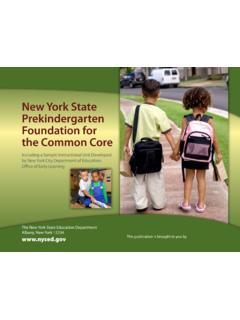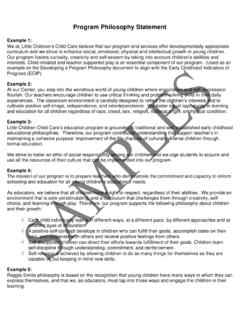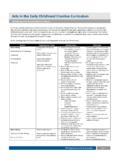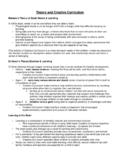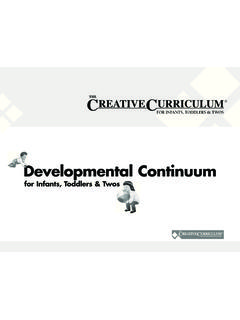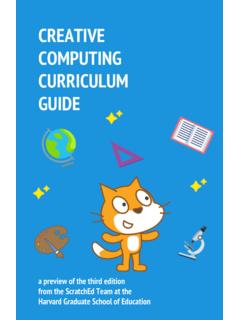Transcription of Alignment of The Creative Curriculum - PDI | Home
1 CurriculumWITHA lignment of The Creative Curriculum for PreschoolAlignment 2013 Teaching Strategies, LLC, 1 Alignment of The Creative Curriculum for Preschool With New York State Early Learning Guidelines This document aligns the content in the New York State Early Learning Guidelines with the goals and ideals of The Creative Curriculum for Preschool. The Creative Curriculum for Preschool is a comprehensive, research-based Curriculum designed to help educators at all levels of experience plan and implement a developmentally appropriate, content-rich program for children with diverse backgrounds and skill levels. References New York State Early Childhood Advisory Council and Council on Children and Families.
2 (2012). New York state early learning guidelines. Rensselaer, New York: Author. Retrieved April 4, 2013 from Teaching Strategies, LLC. (2010). The Creative Curriculum for preschool. Washington, DC: Author. Alignment 2013 Teaching Strategies, LLC, 2 New York State Early Learning Guidelines How The Creative Curriculum for Preschool meets New York State Early Learning Guidelines Physical Well-Being, Health, and Motor Development 36 to 60 Months A. Gross Motor Skills 1. Walks and runs and navigates obstacles and corners Demonstrates traveling skills Moves purposefully from place to place with control 2.
3 Crawls through a play tunnel or under tables Demonstrates traveling skills Experiments with different ways of moving 3. Climbs on play equipment Demonstrates traveling skills Moves purposefully from place to place with control 4. Throws ball overhand with some accuracy Demonstrates gross-motor manipulative skills Manipulates balls or similar objects with flexible body movements 5. Catches large balls with two hands Demonstrates gross-motor manipulative skills Manipulates balls or similar objects with a full range of motion 6. Kicks ball forward Demonstrates gross-motor manipulative skills Manipulates balls or similar objects with flexible body movements 7.
4 Hops forward on one foot without losing balance Demonstrates balancing skills Sustains balance during complex movement experiences 8. Jumps on two feet and over small objects with balance and control Demonstrates balancing skills Sustains balance during complex movement experiences 9. Gallops with skill Demonstrates balancing skills Sustains balance during complex movement experiences 10. Pedals consistently when riding tricycle and navigates obstacles and corners Demonstrates traveling skills Moves purposefully from place to place with control 11. Walks up and down stairs, using alternating feet, without support Demonstrates traveling skills Moves purposefully from place to place with control Alignment 2013 Teaching Strategies, LLC, 3 12.
5 Walks backwards and runs with enough control for sudden stops Demonstrates traveling skills Experiments with different ways of moving B. Fine Motor Skills 1. Eats with utensils Demonstrates fine-motor strength and coordination Uses fingers and hands Uses fingers and whole-arm movements to manipulate and explore objects 2. Uses various drawing and art materials ( , crayons, brushes, finger paint) Explores the visual arts 3. Copies shapes and geometric designs Demonstrates fine-motor strength and coordination Uses writing and drawing tools Grips drawing and writing tools with whole hand but may use whole-arm movements to make marks Uses symbols and images to represent something not present Thinks symbolically Draws or constructs, and then identifies what it is 4.
6 Opens and closes blunt scissors with one hand Demonstrates fine-motor strength and coordination Uses fingers and hands Uses small, precise finger and hand movements 5. Cutting skills progress from inaccurate cutting to proper grasp with some degree of accuracy Demonstrates fine-motor strength and coordination Uses fingers and hands Uses refined wrist and finger movements 6. Manipulates small objects with ease ( , strings beads, fits small objects into holes) Demonstrates fine-motor strength and coordination Uses fingers and hands Uses small, precise finger and hand movements 7. Dresses and undresses self-managing buttons and/or zippers Regulates own emotions and behaviors Takes care of own needs appropriately Demonstrates confidence in meeting own needs Demonstrates fine-motor strength and coordination Uses fingers and hands Uses refined wrist and finger movements Alignment 2013 Teaching Strategies, LLC, 4 8.
7 Uses stapler or paper punch Uses tools and other technology to perform tasks 9. Completes increasingly complex puzzles ( , 3-piece to 10-piece puzzles) Demonstrates fine-motor strength and coordination Uses fingers and hands Uses refined wrist and finger movements 10. Writes some recognizable letters or numbers Demonstrates emergent writing skills Writes to convey meaning Mock letters or letter-like forms C. Sensorimotor Skills 1. Physically reacts appropriately to the environment ( , bends knees to soften landing, moves quickly to avoid obstacles) Demonstrates traveling skills Moves purposefully from place to place with control Demonstrates balancing skills Sustains balance during simple movement experiences Demonstrates gross-motor manipulative skills Manipulates balls or similar objects with flexible body movements 2.
8 Demonstrates concepts through movement ( , imitates an animal through movement, sounds, dress, and dramatization) Uses symbols and images to represent something not present Engages in sociodramatic play Acts out familiar or imaginary scenarios; may use props to stand for something else Explores dance and movement concepts 3. Improves eye-hand coordination ( , catches a bounced ball) Demonstrates gross-motor manipulative skills Manipulates balls or similar objects with flexible body movements 4. Enjoys pushing objects, climbing short ladders, swinging on a swing, and sliding Demonstrates traveling skills Moves purposefully from place to place with control D.
9 Physical Fitness: Daily Activities 1. Carries light objects or backpack for a short distance Demonstrates positive approaches to learning Persists Plans and pursues a variety of appropriately challenging tasks Alignment 2013 Teaching Strategies, LLC, 5 2. Repetitively practices new skills Demonstrates positive approaches to learning Persists Practices an activity many times until successful 3. Engages in at least 60 minutes, and up to several hours, daily of unstructured physical activity Regulates own emotions and behaviors Takes care of own needs appropriately Takes responsibility for own well-being 4. Engages in organized physical activities for a total of at least 60 minutes each day, sustaining physical activity for at least 15 minutes at a time Demonstrates traveling skills Moves purposefully from place to place with control Demonstrates balancing skills Sustains balance during simple movement experiences Demonstrates gross-motor manipulative skills Manipulates balls or similar objects with flexible body movements 5.
10 Stays awake except during nap time Demonstrates knowledge of patterns Shows interest in simple patterns in everyday life E. Physical Fitness: Variety and Well-Being 1. Participates in different physical activities ( , walking, climbing, throwing, dancing) with enthusiasm Regulates own emotions and behaviors Takes care of own needs appropriately Takes responsibility for own well-being 2. Incorporates various physical activities while transitioning from one place to another ( , marches between the kitchen and the bathroom) Demonstrates traveling skills Moves purposefully from place to place with control Demonstrates balancing skills Sustains balance during simple movement experiences Demonstrates gross-motor manipulative skills Manipulates balls or similar objects with flexible body movements 3.
